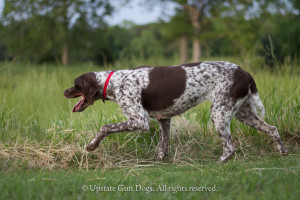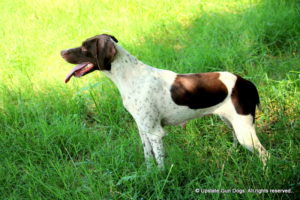Braque Francais (French Pointer) History
Content courtesy of Club Braque Francais.
 The development of the pointing dog style of hunting dates back to the 13th century and continued in earnest into the 16th century. The birthplace of pointing dogs was the Pyrenees Mountains on the France/Spain boarder and the regions north and south. Back in the 13th century, the area was ruled by French monarchy and was known as the Kingdom of Navarre. During the 15th century, the southern area was returned to Spanish rule while the northern area remained under French rule.
The development of the pointing dog style of hunting dates back to the 13th century and continued in earnest into the 16th century. The birthplace of pointing dogs was the Pyrenees Mountains on the France/Spain boarder and the regions north and south. Back in the 13th century, the area was ruled by French monarchy and was known as the Kingdom of Navarre. During the 15th century, the southern area was returned to Spanish rule while the northern area remained under French rule.
While many breed historians credit the Spanish Pointer as the origin for today’s pointing breeds, there is just as as strong an argument for the French dogs as well. Over time, the French Pointers, also known as Braque du Pays (country Braques), were fairly common in France. Smaller populations of Braques became isolated throughout different regions and eventually developed different looks and hunting styles. They eventually became recognized as different breeds; Braque d’Auvergne, Braque du Bourbonnais, Braque St. Germain, Braque de L’Ariege, etc. During the late 1700’s and early 1800’s, with the advent of the industrial revolution, there was a gradual transition from a rural agrarian society to an urban industrial society. The need developed for a smaller, more compact Braque Francais. The larger original BF was not conducive to living in an urban setting.
In the mid to late 1800’s, there was an influx of English Pointers into France. The various French Pointers became less popular but still existed in France.
By the early 1900’s, there were 2 distinctly different types of Braque Francais breeds. The original, larger, closer working BF-Grand Taille was officially renamed the BF-Gascogne in 1975. The smaller, faster, wider ranging BF-Petite Taille was renamed BF-Pyrenees in 1975. The Pyrenees was preferred by those who wanted a dog that was more agile and better equipped to compete against other breeds in field trials and find game birds which were becoming more scarce.
The Club du Braque Francais (CBF) was formed in 1919. There were discussions as to which BF the club would support. While some preferred the original Braque, others felt the newer Braque should be promoted. Eventually, a compromise was made and the club decided to recognize both types and established 2 breed standards.
World War II had a devastating effect on the breed, as it was almost completely wiped out. It took until the the 1960’s for the breed to become re-established. Part of the re-establishment involved back breeding of English Pointers into the Bf-Pyrenees.
 The BF-Pyrenees is by far the more popular today in France, and has a small but devoted group of breeders in Italy, Canada and the United States. The number of Gascogne in France is waning and although there are a few in North America, it has never developed a serious following. The Gascogne gene pool is dangerously narrow and its future is uncertain.
The BF-Pyrenees is by far the more popular today in France, and has a small but devoted group of breeders in Italy, Canada and the United States. The number of Gascogne in France is waning and although there are a few in North America, it has never developed a serious following. The Gascogne gene pool is dangerously narrow and its future is uncertain.
